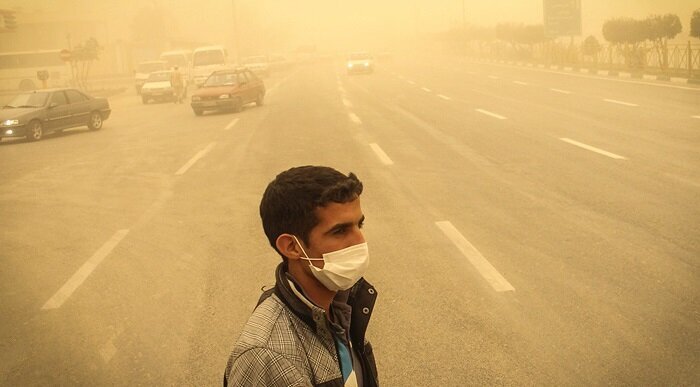Some $70m spent to combat sand and dust storms in 4 years

TEHRAN – The national headquarters for dealing with sand and dust storms has earmarked 21 trillion rials (about $70 million) over the four years from March 2017 to March 2021.
During the mentioned period, some 2.5 million hectares of land have been reforested in line with the measures to combat sand and dust storms, ISNA quoted Ali-Mohammad Tahmasbi, the secretary of the national headquarters for dealing with sand and dust storms, as saying on Saturday.
Referring to agreements signed between the Department of Environment and environmental authorities of the neighboring countries in recent months, he said that the issue of establishing a regional organization was put forward at a ministerial summit which was held in Tehran in July.
On July 12, Tehran played host to 11 countries, aiming to boost cooperation for resolving extant environmental problems, especially sand and dust storms. Iraq and Syria are of the highest importance due to the closeness of their sand and dust storm hubs to Iran, he said, adding that 90 percent of sand and dust storms with an external source come from Syria.
Over the past years, Iraq has always carried out activities to curb sources and sand and dust storms, but the country has not taken any joint measures with Iran so far.
On July 12, Tehran played host to a conference of ministers and officials from 11 countries, aiming to boost cooperation for resolving extant environmental problems, especially sand and dust storms.
Environment ministers of Iraq, Armenia, the United Arab Emirates, Oman, Syria, and Qatar, as well as deputy ministers of Azerbaijan and Turkmenistan along with delegations from Turkey and Uzbekistan, participated in the event which was held with the theme of “Environmental Cooperation for a Better Future.”
Addressing the opening ceremony, President Ebrahim Raisi emphasized that the preservation of the environment is essential and an inevitable priority.
Raisi had earlier obliged the department of environment to diligently pursue the solution of sand and dust storms through diplomacy and international forums, as well as interaction with neighboring countries.
“Conservation of the ecosystem and environment, which is a global concern, especially for countries of the region, is an inevitable priority today. If the environment is not safe and peaceful for people, the development will not be in its proper place and it will even become a threat to human health,” Raisi stated.
UNDP Representative in Iran Claudio Providas has emphasized the need for cooperation with the country to address environmental challenges.
in a meeting in June with Department of Environment Chief Ali Salajeqeh in Tehran, he criticized the U.S. sanctions, announcing readiness for tackling environmental issues in Iran through the support of the United Nations Development Program.
“We strive to raise funds to strengthen support, and the second issue is to move from environmental protection to existing opportunities for investment and a knowledge-based economy, and we must focus on energy, environment, and agriculture, which play an important role in development,” he added.
Elsewhere in his remarks, he expressed readiness to cooperate in dealing with sand and dust storms, suggesting negotiations with Iraq, Syria, and Afghanistan.
Effects of sand and dust storms
The SDSs phenomenon has been plaguing the country for several years and has caused problems in many provinces. According to experts, natural and human factors are involved in the occurrence and severity of this phenomenon which is mainly caused by excessive consumption of water and drying up reservoirs.
The internal dust sources are estimated at 34.6 million hectares, generating an average amount of 4.22 million tons of dust per year, about 1.460 million hectares are dried wetlands.
Some 4.23 million tons of dust are raised per year, which means the loss of soil fertility will hit the agricultural sector.
All the SDSs sources are not located in Iran, 300 million hectares in the neighboring countries are giving rise to SDSs, which transport dust into Iran. The total dust density is estimated at about 150 million tons.
In fact, the dust is raised from Turkmenistan, Uzbekistan, Afghanistan, and Pakistan in the northeast as well as Iraq, Syria, Saudi Arabia, and Jordan in the south, southwest, and west.
Letizia Rossano, the director of the Asian and Pacific Centre for the Development of Disaster Information Management (APDIM), said in June that Iran is really at forefront of understanding the problem of sand and dust storms as well as dealing with it.
More than 80 percent of the entire populations of Turkmenistan, Pakistan, Uzbekistan, Tajikistan, and the Islamic Republic of Iran are exposed to medium and high levels of poor air quality due to sand and dust storms," she noted.
MG
